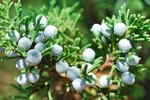
The best-known pet grass is cereal grains grown to be fed to pet animals, from pocket pets, such as hamsters and guinea pigs, to cats, dogs and birds. It can be grown indoors or out, in soil or in water, and it provides fresh food high in nutrients.
Seeds
Many grains can produce pet grass. Wheat is popular, as are oats and rye, but from a nutritional standpoint, barley is superior, producing green shoots that are 40 percent protein, of which 90 percent is easy to digest and assimilate; it's also high in vitamins (more vitamin C than oranges), minerals and amino acids. Even some of the more exotic grains, such as quinoa and chia, can be used to grow a tasty snack for pets.
Growing Medium
Pet grass grown indoors or outdoors can do well in almost any type of soil, as long as the variety is appropriate for that type of soil (sandy, clay, loam and so on). Indoors, commercial potting soil works well. If you choose to go the hydroponic no-soil route, you still need something to support the plants, and this can be anything from gravel, perlite or vermiculite to perforated plastic, as long as the roots can dig in and grow and the tops stay upright. You can plant pet grass in almost anything and even on some things. Any shallow dish that will hold a growing medium and water will do, or even a porous clay pot or figurine with a surface grooved to hold seeds (a Chia Pet).
Nutrients
Even a thin layer of soil will provide enough nutrients to grow pet grass short-term. If you're going soil-less, you'll need to add nutrients to the water so that the grass can absorb them. Balanced hydroponic solution can be made from scratch, but it's much easier to buy liquid or powdered fertilizer and dilute it. Hydroponics kits are readily available for beginners.
Water
Good water is as essential to growing pet grass as it is to any other plant. You'll need to check the mineral content of your water to see if it's hard or soft and adjust this according to the type of grain you're planting. The one thing you cannot use is water that has been through a water softener -- there's waaaaay too much salt in it. If your tap water is softened, you'll need to get some before it goes into the softener (try an outdoor faucet), use bottled water or collect rainwater for your pet grass. Since the growing medium is thin, you'll probably need to water the pet grass every day.
Light
Pet grass grows fastest in indirect light. Too much direct sun dries out the soil quickly and the seeds can't grow well. Outdoors, plant your grass where it is shaded during the hottest part of the day. Indoors, place it near a window where it will get plenty of light but no direct sun. You can even grow it under artificial light.
Harvesting
Pet grass reaches its maximum nutritional value when it's about 7 inches high, which should happen in 7 to 10 days. At this point you can cut it off just above the roots and feed it to your pet, or, if you've planted it in a small enough container, just offer it still growing and let your pet do the harvesting. It's a good idea to plant several small containers several days apart, so that you will always have fresh grass to offer. Don't worry if your pet eats the roots, too -- they're also highly nutritious and tasty.
References
Resources
Photo Credits
-
Digital Vision/Photodisc/Getty Images



